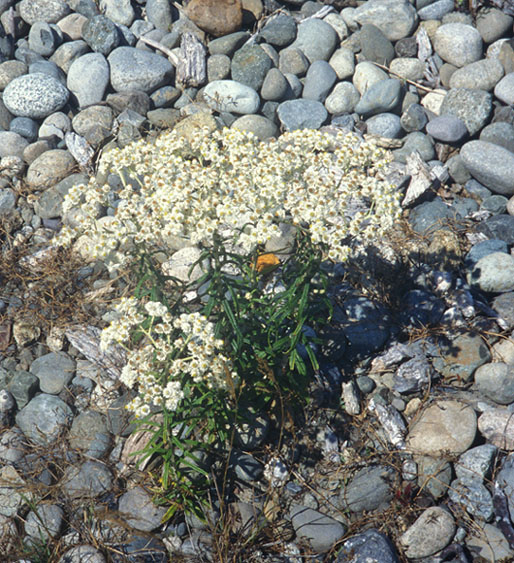
|
| Pearly Everlasting; Anaphalis margaritacea (L.) Benth. & Hook. |
Sunflower Family; COMPOSITÆ (ASTERACEÆ)
|
| Pearly Everlasting is not totally weedy. In fact, it is no such thing to some people. Most weeds (of the brazen, unapologetic class)
are less attractive yet more aggressive. One can say the same thing about most politicians. So, if we call Pearly Everlasting a weed,
we must, to be fair, also acknowledge its being a native wildflower, pretty enough that some of us grow it intentionally. |
| The native range of this plant is vast: NE Asia, Alaska, Canada and the northern U.S. Moreover, it is naturalized in Europe
and elsewhere as well. Hikers are familiar with it even in high elevations. Like fireweed (Weed-of-the-Month July 1988), it thrives in
burn sites. The dusty dry roadsides, vacant lots, and sunny waste areas of lowland Washington also supply plenty of Pearly
Everlasting. Even, therefore, that it is not a common garden pest, it is so eyecatching where it does grow, that we should all know it. Whether
we call it a weed or wildflower is a personal choice. |
| Everlasting flowers such as strawflowers, commonly used for dried floral arrangement, are a varied lot, yet a majority are in
the sunflower family (compositæ), as is Pearly Everlasting. If its flowers didn't last so long, the plant would be of much less interest to us. |
| It is a clump-forming perennial that dies to its roots each winter. In spring, shoots emerge and grow 1 to 3 feet tall. Each stem
is slender, coated with cobwebby white hairs that can be rubbed off, and has long leaves: skinny, green above, white wooly
underneath. The flowers, commencing in June, are borne in stem-top clusters of up to nearly 100 little button-like heads, each about 1/3 to 1/2
inch wide, consisting of chaffy pearly-white outer portions and tawny, fertile central parts. Curiously, each individual plant either
bears male or female florets. |
Some Indians used the dry flowers, available for roughly 5 months (July into November), to stuff pillows. The longevity of
the floral display, plus the drought-tolerance and general toughness of the plant, recommend it for low-maintenance dry plantings.
Its name Anapahlis is an anagram of Gnaphalium, a related genus called cudweeds; last month's feature. Margaritacea is from Greek margaron, a pearl. The herbal medicinal uses of Pearly Everlasting are minor. Other names are Silverleaf, Cottonweed,
Moonshine, and the pleasantly unambiguous None-so-Pretty.
|
Originally published as the Seattle Tilth newsletter Weed of the Month in December 1993, along with an illustration from a book.
Back |
|
|

